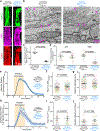Caveolae in CNS arterioles mediate neurovascular coupling
- PMID: 32076269
- PMCID: PMC7060132
- DOI: 10.1038/s41586-020-2026-1
Caveolae in CNS arterioles mediate neurovascular coupling
Abstract
Proper brain function depends on neurovascular coupling: neural activity rapidly increases local blood flow to meet moment-to-moment changes in regional brain energy demand1. Neurovascular coupling is the basis for functional brain imaging2, and impaired neurovascular coupling is implicated in neurodegeneration1. The underlying molecular and cellular mechanisms of neurovascular coupling remain poorly understood. The conventional view is that neurons or astrocytes release vasodilatory factors that act directly on smooth muscle cells (SMCs) to induce arterial dilation and increase local blood flow1. Here, using two-photon microscopy to image neural activity and vascular dynamics simultaneously in the barrel cortex of awake mice under whisker stimulation, we found that arteriolar endothelial cells (aECs) have an active role in mediating neurovascular coupling. We found that aECs, unlike other vascular segments of endothelial cells in the central nervous system, have abundant caveolae. Acute genetic perturbations that eliminated caveolae in aECs, but not in neighbouring SMCs, impaired neurovascular coupling. Notably, caveolae function in aECs is independent of the endothelial NO synthase (eNOS)-mediated NO pathway. Ablation of both caveolae and eNOS completely abolished neurovascular coupling, whereas the single mutants exhibited partial impairment, revealing that the caveolae-mediated pathway in aECs is a major contributor to neurovascular coupling. Our findings indicate that vasodilation is largely mediated by endothelial cells that actively relay signals from the central nervous system to SMCs via a caveolae-dependent pathway.
Conflict of interest statement
Competing Interests:
The authors declare no competing financial interests.
Figures














References
Method References
Publication types
MeSH terms
Substances
Grants and funding
LinkOut - more resources
Full Text Sources
Other Literature Sources
Molecular Biology Databases
Research Materials

